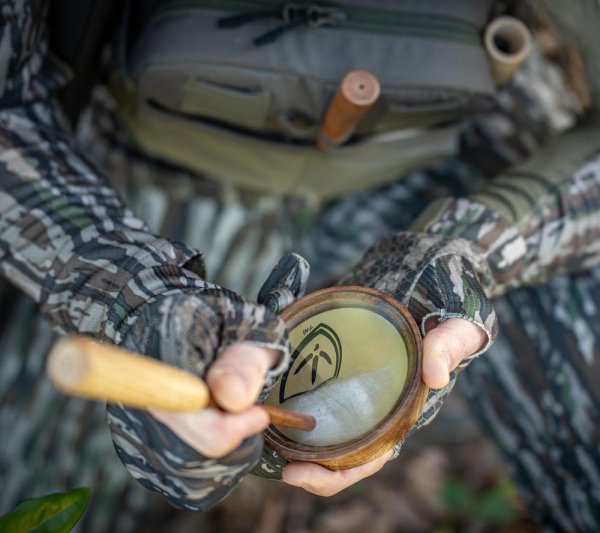

|
Turkey seasons are well underway across the country, but many states have seasons that extend to Memorial Day, or even early June! Turkey hunters know there aren’t many experiences that match the sight and sounds of a stud gobbler sashaying into shotgun range, especially when they come to the call. And refining the craft is always more effective during real time hunting scenarios.
Calling turkeys is intrinsic to the American hunting heritage and while many hunters are content with their abilities, there is always room for improvement and refinement. Pro turkey callers don’t just stumble into good calling, they earn it through practice and by honing their abilities with a wide range of calls.
“I started turkey hunted when I was 14, almost 30 years ago now, and started dabbling in call making late in high school,” said the turkey calling virtuoso and Blocker Outdoors Elite Pro, Jason Powell. “I served in the United States Army as a Combat Engineer and was severely injured in Afghanistan in 2012. I am a Purple Heart recipient, and a disabled veteran.”
When Powell returned from Afghanistan, in 2013, he started making calls at home and competing in calling contests. “I've been fortunate to win calling contests in multiple states and I now travel the country to compete in major contests, but I also enjoy supporting as many local contests as I can.”
A turkey hunting fanatic, he officially started his own call making business Jason Powell Custom Calls in 2021. While he also enjoys wildlife video and photography, as well as archery hunting whitetails, turkey maintain an extra special place in his heart.
Question: There are multiple styles of calls capable of producing a range of vocalizations and most turkey hunters are content to work with a couple basic sounds. Could you list the calls you feel are the easiest to master, as well as the most difficult.
Powell: I feel box calls are the best choice to make realistic turkey vocalizations the fastest. The high-honk-rasp is built-in and with some focused practice and listening to real turkey vocalizations, anybody can produce incredible turkey sounds in a short period of time.
Friction calls (pot calls) are probably the second easiest type in my opinion. There is a lot more room for error with friction calls than box calls, so the caller must know their call and its capabilities, which obviously comes with practice.
Mouth yelpers (diaphragms) pose a significantly higher level of challenge than the handheld calls. Without a significant amount of practice, it’s difficult to get the proper air control to produce realistic turkey sounds.
Suction type callers including trumpets and wing bones are the most difficult calls to produce realistic turkey sounds with, at least for me. This style of call requires an almost overwhelming amount of practice to consistently produce realistic turkey sounds.
Question: There are variants of each style of with different configurations and materials, and each one produces unique sounds and may require specific operation to maximize their potential. Can you expand on which materials are good for different scenarios and perhaps more important to this discussion, the easiest to master, and which ones are your go-to.
Powell: There are diverse styles of each type, and they all perform in different ways – different length box calls, different calling surfaces on friction calls, and all kinds of different cuts on mouth calls.
I like to keep things simple when I’m hunting, so I carry a normal short box, and I also carry slate, glass, and ceramic friction calls with a few strikers to match them. For mouth calls, I like the modified split V and ghost cuts.
Mouth yelpers really depend on the person, and they are more tailored to the user than any other type of call with different cuts and tensions available.
When it comes to box calls, you basically have a long box and a short box, the short being the most common, and it will produce anything you need in the way of turkey vocalizations. This call gets loud, but you can still tone it down as necessary. A long box will produce a few other vocalizations a little easier than a short box, specifically kee-kee runs and gobbler/jake yelps, as well as every other vocalization the short box produces. With box calls, I suggest finding a call you like and sticking with it.
Friction calls have a seemingly endless number of variations in call construction and these calls can really work for anybody. If you start with a slate surfaced call, you can increase pitch and volume by going to ceramic, glass crystal, and metal surfaces basically in that order. Glass, crystal, and metal surfaced calls are a lot higher maintenance than a slate or ceramic call, but it’s hard to beat a good old slate call.
Question: There are basic vocalizations hunters can become proficient at that will be of value in any situation. Which sounds do you consider the building blocks of the turkey hunter’s repertoire.
Powell: The foundation of all calling is based off the hen yelp. Master the hen yelp on whatever type of call you choose, and you can pull other vocalizations from that basic yelp. There are a few outliers, but if somebody learns to simply hen yelp, they can call a turkey in while hunting. And, from the yelp you can easily learn to cutt and kee-kee run, and vary that yelp into different styles as well.
On the opposite end of the spectrum there are more advanced vocalizations such as cutting routines, purring, and of course gobbling. Which calls work best for these more advanced sounds?
Apart from owl hooting and gobbling, every turkey sound can be produced on a friction call (pot call), but the most realistic gobbles come from mouth yelpers – though I have heard some decent gobbles produced on box calls as well.
Question: How important is it to "break-in" diaphragms and how do you make them last longer?
Diaphragms will change from the first time or two that you use them. You want a consistent call every time you head to the woods, buy your calls before season and do not wait till the night before to start practicing.
Powell: With proper care, diaphragm calls can last many years. I keep mine in the freezer after every use and carefully place toothpicks between each reed, as well. The plastic picks because the wood ones tend to stick to the reeds. I still have some calls from 2009 in my freezer that I ran yesterday that sound just fine!
Question: How important is call care and maintenance and what do you do to maintain your calls in proper working condition?
Powell: Care and maintenance are crucial with turkey calls. Nobody wants to throw money away, so basic care and maintenance can make your investment last for many years. Keeping chalk on a box call certainly helps prevent wearing the rails down faster than they should, and it typically keeps the call sounding great as well. I always clean the old chalk off my box calls before season with steel wool and apply new chalk, and I store box calls at room temperature and in a dry place as well to prevent the wood from distorting.
Friction calls need regular maintenance to keep them performing to their potential as well. You'll want to keep the conditioned area of the call scuffed and free of residue and the same for the tip of the striker. It is also vitally important that friction calls are stored in a dry area at room temperature as well.
For mouth calls, I keep it simple. If they are too nasty, they go in the trash can! I do rinse my mouth calls under cool water and store them in the freezer, and of course I use the picks to keep the reeds separate.
Question: Practicing is critical but a lot of turkey hunters struggle because people in their midst don’t want to hear it! What is your best advice for when and where to practice – what is your regular routine and what resources do you recommend?
Powell: I try to dedicate an hour or two per day to calling practice year-round. Yes, it annoys my entire family…it probably annoys my dogs when they are trying to sleep as well, but I get in at least an hour or two of practice per day. I do try to call outside as much as I possibly can, but the weather isn’t always on my side to do that!
When I practice, I focus on a few different things, one being mechanics. I will focus time simply on the mechanics of running a turkey call – whatever type of call that may be. When I really focus on what I am producing from the turkey call, I will be listening to real turkey audio as well as recording myself, which allows me to compare the two over and over and be hyper critical of myself. These extremes aren’t exactly necessary to just go out and fill your tag, though!
As a competitive turkey caller, my standard of vocalization quality is significantly higher than most turkey hunters. I am very picky about the sound quality of my calls whether it be hunting or competition, but you don’t have to be an incredible turkey caller to be a great turkey hunter. It helps, but it isn’t a requirement.
I do encourage every turkey hunter to try different types of turkey calls. If nothing else, a little bit of proficiency will add more options to your toolbox and potentially increase success. No matter what call anybody chooses to use, the most important thing is PRACTICE!
The easiest way to learn these vocalizations is to first listen to real turkeys and watch tutorials by reputable callers and hunters that are all over social media and YouTube. I produce my own tutorial videos on how I personally call that can be found on my social media pages as well as Blocker Outdoors social media pages. I’m also currently working on more in-depth videos that will be out there soon.